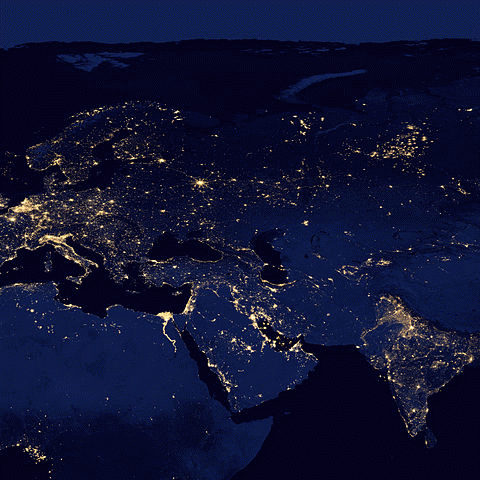Once the financial economy evades the controls set on it by the real economy, it mimics the real economy. It is also a non-self-limiting, self-organizing system, one whose environment off which it feeds is the real economy. It too is subject to overgrowth on its environment, the real economy, and collapse.
Now in the late stages in the growth of our real economy, the financial sector is taking over. The resources available to the real economy to limit the growth of the financial economy are diverted away, in part by increasing real costs in the rest of the economy and in part by the manipulations of the financial sector itself. Regulation then fails. (One thing that happens is the value of non-financial rewards offered by the society declines, and become devalued, reducing the cost of corrupting officials.) The financial sector then grows until it exceeds the ability of the real economy to sustain it. It grows much more rapidly than the real economy did, since the financial infrastructure is much less expensive to develop than the real infrastructure. (Increasingly, the financial economy diverts resources from the real economy to itself. It does this by making finance nominally more profitable than real investment, thus diverting money, that is demand, on resources from the real economy. This causes deflation in the real economy, even as the quantity of various forms of money in the financial economy increases without bounds. This is accompanied by ever greater concentration of wealth, and ever more extravagant expenditure. This growth is in the demand side of the economy, which conceals decline in the extracting and manufacturing sectors. GDP, for instance, does not distinguish between growth in producing sectors and growth in consuming sectors.
The real increasing costs of maintaining the real economy, (and in particular its infrastructure,) and the increasing real costs of its extraction of real resources from the natural environment, are hidden by the mechanisms of externalization of costs, both directly onto the environment (pollution) and onto labor, by government subsidies, by defaulted debts, and by the deferred maintenance of the real infrastructure. These manipulations make the cost of extraction, transport and fabrication of real resources appear cheaper than they really are. However, while in nominal terms the costs are reduced, in real terms the costs cannot be reduced, and must increase over time. The real costs of these manipulations, however, transfer these costs onto other parts of the producing sector. This increases the costs of production in these sectors, an increase greater than the reduction in apparent nominal costs. These manipulations of the real economy, as well as the financial manipulations which enable them, enrich the financial and consuming sectors, and impoverish the actual producers of real goods and services. The productive sectors are deprived the real resources necessary to grow, and ultimately to maintain themselves.
This financial extraction becomes ever more difficult and costly, as the real economy becomes progressively impoverished. This decline in efficiency means more labor is required for the extraction of wealth from the real economy. Thus, even though most labor is no longer involved in real extraction and production, there results the paradox of an increasing burden on labor in non-productive jobs. However, because of the decreasing efficiency, the profit to be made off these jobs is very low, and decreasing, and the pay must be commensurate.
Meanwhile, since the cost of all maintenance increases, the cost of maintaining the burden of the financial and consuming sectors is also increasing. As the concentration and availability of extractable community assets declines, the costs required for extraction increase, the actual financial profits decline to zero and even go negative. This is obscured by the fact that these financial costs are increasingly externalized onto the real economy.
The degree of financial exploitation is not reduced, but merely more resources are devoted to the process. Even as this happens, fewer resources are available to the real economy. This is both because the financial sector externalizes its costs onto it onto the real economy, (and thus appearing artificially profitable,) and because greater real resources must be expended in acquiring resources from an increasingly impoverished natural environment. Combined, these processes render the usual indicators of economic health and prosperity at least useless and even more likely misleading. Much growth occurs in the wrong sectors, and is indicative of impending failure, rather than success.
Mankind has yet to develop a self-limiting economy. Since economies ultimately serve a population, clearly, with unrestricted population growth, no self-limiting economy is possible. And any non-self-limiting economy will be subject to the growth trap.
More to the present, however, there is no evidence that capitalism is self-limiting. Only a self-limiting economy can survive the growth trap. Only an economy which can limit its consumption of renewable resources to some rate less than the rate those resources are renewed, and its consumption of non-renewable resources to some rate less than those resources can be recycled, can be indefinitely sustained. All other economies will fail. And a failing economy will be incapable of providing sufficient resources for the survival of most of its members. Indeed, because of the enormous efficiencies brought about by a modern economy, if that economy fails, such a failure will be catastrophic, and only small percentage of the people who depend on that economy can be expected to survive.
The point being, when- if the global economy reaches the limit to growth, or, for that matter even gets too close, it will be too late. Economic catastrophe will be unavoidable. The only definite sign will come too late.
There still seems a choice, however, although our political class seems incapable of confronting the issue.





